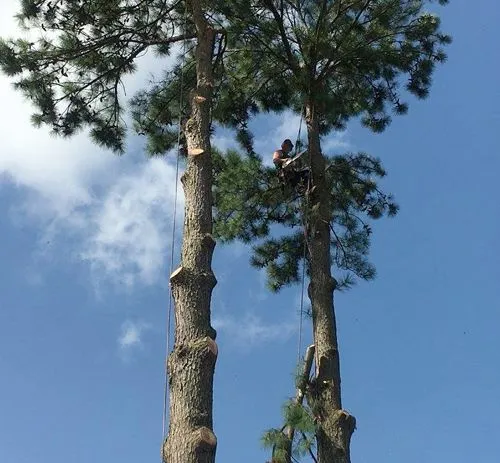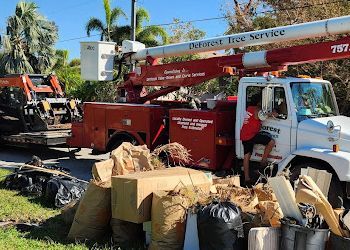DeForest Tree Service Blog
We invite you to monitor our News Blog for informative articles.

Large trees can be beautiful and beneficial to your property. However, when a tree begins to show signs of decline or structural weakness, it can quickly become a serious hazard. Being able to recognize the warning signs that a tree is becoming dangerous is crucial to protecting your home, your family, and your neighbors. At DeForest Tree Service, we can accurately identify and safely remove hazardous big trees. Here are five signs that a big tree may be posing a safety risk and should be inspected by a professional arborist. Leaning More Than Usual While some trees naturally grow at an angle, a sudden or increasing lean can be a red flag. A significant lean, especially when accompanied by soil movement or exposed roots on one side, may indicate that the tree is unstable and at risk of falling. This is especially concerning after storms or periods of heavy rain, which can loosen the soil and make the tree more likely to topple. Large Dead or Falling Branches If you’re noticing large dead branches or limbs falling from the canopy, your tree may be in trouble. These dead limbs can fall without warning, especially during high winds or storms, and pose a threat to anything beneath them. A tree that is shedding large branches or has many dead limbs in the canopy could be experiencing disease or decay that weakens its structure. Visible Trunk Cracks or Cavities Cracks or cavities in the trunk of a large tree can compromise its structural integrity. Deep vertical splits or open hollows may indicate internal decay. Over time, these weak spots can worsen and make the tree more susceptible to breaking or falling. If you see deep cracks or signs of internal rot, it’s time to get a professional assessment. Signs of Root Damage Since tree roots are mostly underground, root damage can be hard to detect. However, symptoms like mushrooms growing around the base, soft or decaying wood near the roots, and an unstable tree base may all indicate root problems. Root damage weakens the tree's support system and greatly increases the risk of collapse. Excessive Dieback or Sparse Foliage A healthy tree should have full, vibrant foliage during the growing season. If your tree has significant dieback—where branches are bare or leaves are sparse and discolored—it could be suffering from disease or pest infestation. This lack of healthy growth is often a symptom of deeper issues and can signal that the tree is weakening from the inside out. Tree Removal in Virginia Beach, VA When you need an experienced arborist in Virginia Beach and the surrounding area, contact DeForest Tree Service at 757-241-4211 . Feel free to give us a call to arrange an arborist estimate in Virginia Beach!

Sweetbay magnolia (Magnolia virginiana) is a beautiful, ornamental tree known for its fragrant white flowers and elegant, glossy green leaves. While it generally requires minimal pruning, there are situations where crown reduction may be beneficial. Crown reduction is a strategic pruning technique that helps maintain the tree’s size, shape, and structural integrity while promoting healthy growth. At DeForest Tree Service, we provide expert crown reduction in the greater Virginia Beach area. Here’s a short overview of crown reduction for sweetbay magnolias. When to Consider Crown Reduction Crown reduction is typically recommended when a sweetbay magnolia has outgrown its space, has sustained storm damage, or is exhibiting signs of structural weakness. Unlike topping, which removes large portions of the tree indiscriminately, crown reduction is a precise approach that selectively trims back branches to reduce height and spread without compromising overall health. It’s especially useful in urban landscapes where space is limited, or near structures where overhanging branches pose a risk. Best Practices for Crown Reduction To successfully perform crown reduction on a sweetbay magnolia, careful pruning techniques must be used to avoid excessive stress on the tree. Branches should be cut just above a lateral branch or bud to encourage proper regrowth. The goal is to reduce the overall size while maintaining the natural shape of the tree. Over-pruning can lead to weak growth and increased susceptibility to pests and diseases. Ideally, no more than 25% of the tree’s canopy should be removed in a single pruning session to prevent shock. Long-Term Benefits of Crown Reduction A well-executed crown reduction offers multiple benefits, including improved tree stability, enhanced aesthetics, and reduced risk of branch failure. By carefully managing the canopy, the tree remains healthier and more resistant to environmental stressors such as heavy winds. Also, maintaining an appropriate size helps the tree coexist harmoniously within its landscape, preventing contact with nearby structures and other plants. Arborist in Virginia Beach, VA When you need an experienced arborist in Virginia Beach and the surrounding area, contact DeForest Tree Service at 757-241-4211 . Feel free to give us a call to request an arborist estimate in Virginia Beach!




